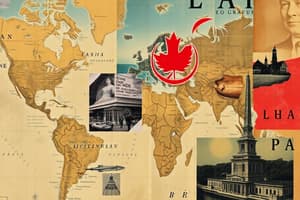Podcast
Questions and Answers
What are the two main branches of geography, and what do they examine?
What are the two main branches of geography, and what do they examine?
The two main branches are Physical Geography, which examines natural features like landforms and climate, and Human Geography, which focuses on human activities and their impacts.
Define absolute location and relative location in geography.
Define absolute location and relative location in geography.
Absolute location refers to exact coordinates using latitude and longitude, while relative location describes a place's position in relation to other locations.
Explain the difference between formal, functional, and vernacular regions.
Explain the difference between formal, functional, and vernacular regions.
Formal regions are defined by uniform characteristics, functional regions are organized around a central node, and vernacular regions are perceived by people based on cultural identity.
What is GIS, and how is it used in geography?
What is GIS, and how is it used in geography?
Describe the role of remote sensing in geographical studies.
Describe the role of remote sensing in geographical studies.
What are the main challenges associated with urbanization?
What are the main challenges associated with urbanization?
How do scale and projections affect map interpretation?
How do scale and projections affect map interpretation?
What does sustainability in geography encompass?
What does sustainability in geography encompass?
Flashcards are hidden until you start studying
Study Notes
Definition and Scope
- Geography: The study of the Earth’s landscapes, environments, and the relationships between people and their environments.
- Branches:
- Physical Geography: Examines natural features (landforms, climate, vegetation).
- Human Geography: Focuses on human activities and their impacts (cultures, economies, urban development).
Key Concepts
-
Location:
- Absolute Location: Exact coordinates (latitude and longitude).
- Relative Location: Location in relation to other places.
-
Place:
- Characteristics that define a location, including physical and human aspects.
-
Region:
- Areas defined by common features, such as language, culture, or climate.
- Types: Formal (uniform characteristics), Functional (served by a node), Vernacular (perceived regions).
-
Movement:
- The mobility of people, goods, and ideas across space.
-
Human-Environment Interaction:
- How humans adapt to and modify their environment.
Tools and Techniques
-
Maps: Visual representations of areas, showing various features.
- Types: Topographic, Political, Thematic, Physical.
-
GIS (Geographic Information Systems):
- Technology used for spatial analysis and mapping.
-
Remote Sensing:
- Collecting data about the Earth’s surface through satellites or aerial photography.
Physical Geography
-
Landforms:
- Mountains, valleys, plains, plateaus, deserts.
-
Climate and Weather:
- Atmospheric conditions, temperature, precipitation patterns.
-
Ecosystems:
- Interactions between organisms and their physical environment.
Human Geography
-
Demographics:
- Study of populations (size, distribution, density).
-
Cultural Geography:
- Examines cultural practices, identities, and landscapes.
-
Economic Geography:
- Focuses on production, distribution, and consumption of goods.
Global Issues
-
Urbanization:
- Growth of urban areas and its challenges (housing, infrastructure).
-
Sustainability:
- Balancing environmental health, economic vitality, and social equity.
-
Globalization:
- Increasing interconnectedness of economies, cultures, and populations.
Important Concepts in Cartography
- Scale: Ratio between distance on the map and distance on the ground.
- Projections: Methods of representing the curved surface of the Earth on a flat map (e.g., Mercator, Robinson).
- Symbols and Legends: Tools to decode the information presented on maps.
Conclusion
- Geography is integral to understanding the world and solving contemporary issues through the interaction of natural and human systems. It provides essential insights into planning, resource management, and environmental conservation.
Geography: The Study of Earth and its People
- Geography encompasses the study of Earth's landscapes, environments, and the interconnectedness of people to their surroundings.
- Physical Geography: Examines Earth's natural features including landforms, climate, and vegetation.
- Human Geography: Focuses on the distribution and impact of human activities like cultures, economies, and urban development.
Key Concepts in Geography
- Location: Refers to a place's position on Earth.
- Absolute Location: Refers to the exact coordinates using latitude and longitude.
- Relative Location: Describes a place's position in relation to other places.
- Place: Defines a location's unique characteristics, encompassing both physical and human aspects.
- Region: Areas defined by common features, such as shared language, culture, or climate.
- Formal Regions: Defined by uniform characteristics.
- Functional Regions: Areas connected by a shared purpose or function.
- Vernacular Regions: Perceived regions based on cultural beliefs or popular understanding.
- Movement: Describes the mobility of people, goods, and ideas across space.
- Human-Environment Interaction: Examines how humans adapt to and modify their environment.
Geographic Tools and Techniques
- Maps: Visual representations of areas displaying various features.
- Topographic Maps: Show elevation and landforms.
- Political Maps: Show boundaries and political divisions.
- Thematic Maps: Highlight specific data or themes.
- Physical Maps: Focus on physical features like mountains and rivers.
- GIS (Geographic Information Systems): Technology used to analyze and map spatial data.
- Remote Sensing: Collecting data about Earth's surface using satellites or aerial photography.
Branches of Geography:
Physical Geography
- Landforms: Earth's physical features like mountains, valleys, plains, plateaus, and deserts.
- Climate and Weather: Focuses on the atmospheric conditions, including temperature and precipitation patterns.
- Ecosystems: The interactions between organisms and their physical environment.
Human Geography
- Demographics: The study of populations, including size, distribution, and density.
- Cultural Geography: Examines cultural practices, identities, and how they shape landscapes.
- Economic Geography: Focuses on the production, distribution, and consumption of goods.
Global Issues in Geography
- Urbanization: The growth of urban areas and the challenges they face like housing and infrastructure.
- Sustainability: Finding balance between environmental health, economic growth, and social well-being.
- Globalization: The interconnectedness of economies, cultures, and populations on a global scale.
Cartography and Mapmaking
- Scale: The ratio between distances on a map and the corresponding distances on the ground.
- Projections: Methods of representing Earth's curved surface on a flat map.
- Examples include the Mercator and Robinson projections.
- Symbols and Legends: Visual keys used to understand the information depicted on maps.
Geography's Importance
- Geography provides essential insights for solving contemporary issues like urban planning, resource management, and environmental conservation.
- It helps us understand the complex interaction between natural and human systems, contributing to a deeper understanding of our world.
Studying That Suits You
Use AI to generate personalized quizzes and flashcards to suit your learning preferences.




